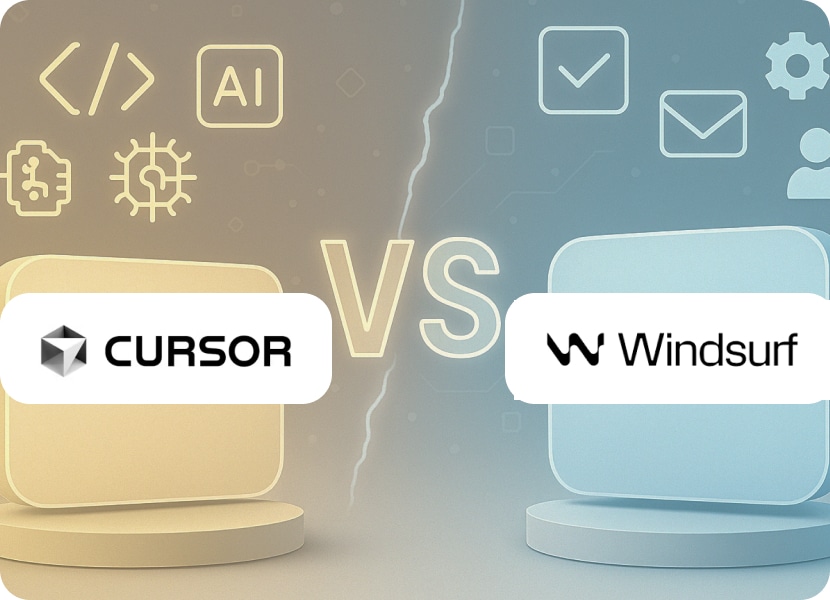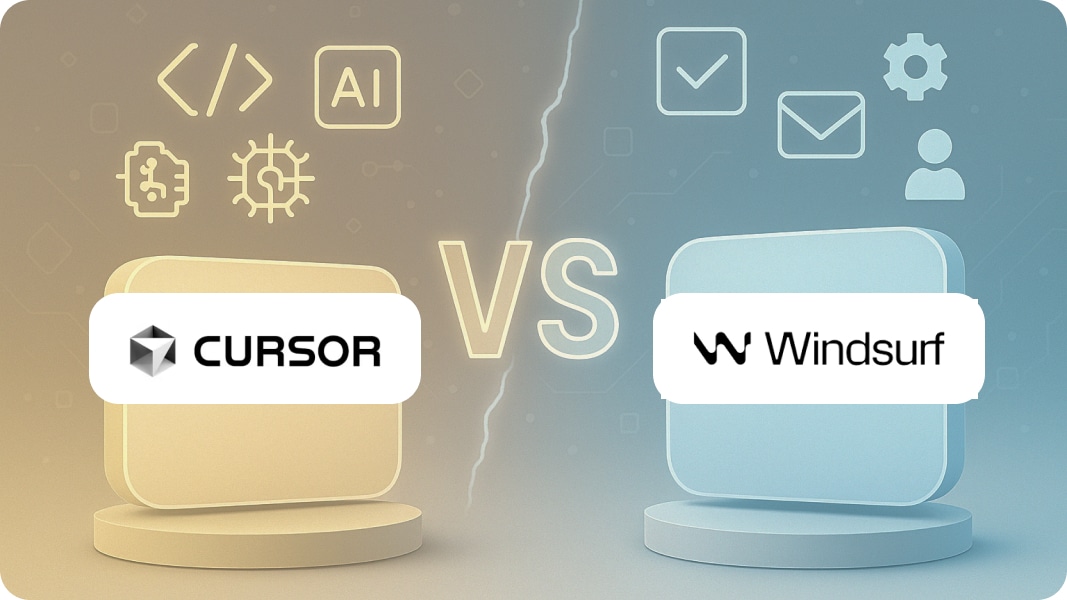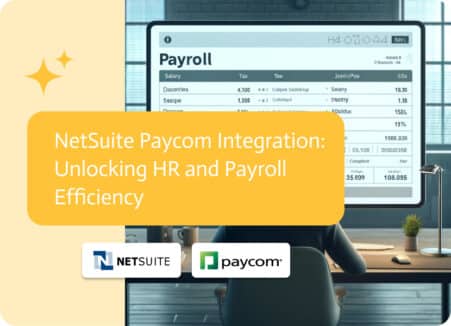

Cursor vs. Windsurf: The Developer Civil War
In early 2025, something strange happened. Developers who used to fight about tabs and spaces suddenly had a new holy war on their hands, and this one is important. The Cursor vs. Windsurf debate has divided engineering teams, turned Slack channels into battlefields, and sparked the kind of fierce tribal loyalty that usually only happens with Vim vs. Emacs.
This is interesting because both sides are technically right. In just 12 months, Cursor reached $100 million in annual recurring revenue (ARR), making it the fastest tool ever to do so. Windsurf (formerly Codeium) was named a Leader in the 2025 Gartner Magic Quadrant for AI Code Assistants. OpenAI bought it for $3 billion. These aren’t just scrappy new businesses making big promises; they’re real platforms that are changing how millions of developers do their jobs.
The Cursor vs. Windsurf civil war isn’t about prices or features. It’s about your beliefs, how you work, and how you think vibe coding should feel when you’re in the zone at 2 AM fixing a bug in production.
The Cursor vs. Windsurf camps have formed, and they won’t back down.
Let me show you what this split looks like in the real world.
Team Cursor is made up of individual developers who put speed, local context, and quick prototyping in VS Code at the top of their list of priorities. These developers say things like “Cursor feels like VS Code + ChatGPT on steroids” and “Composer saves me from yak-shaving.” They love that Cursor looks and feels just like VS Code. Existing themes, keybindings, and extensions can be moved over with just one click.
Cursor’s Composer works well with the editor’s ergonomics and diff flow. You can see the AI output in a side panel and choose which diffs to use with fine control. That control is everything for these developers. They want AI to help them, not to be free.
Team Windsurf is for developers who work on big, complicated codebases and need to understand how multiple files work together better. People are saying things like “Windsurf’s Cascade blew my mind” and “coding’s future isn’t just here, it’s thinking.” Windsurf feels like an opinionated AI-first IDE that was made from scratch with the idea that AI should automatically understand the whole context of your project.
The Cascade feature in Windsurf was the first AI IDE agent that could automatically fill in context, run commands, and work with more than one file without you having to tell it which files to look at. You usually have to add the context or tag the codebase in Cursor, but Windsurf will automatically look at the codebase and pick the right file to work on.
Both groups are evangelicals. Both have receipts. And both are sure that the other side is missing something very clear.
Cursor vs. Windsurf: What Makes Them Different (Besides the Hype)
Let’s stop the tribal fighting and talk about the real differences that matter when you send code.
Handling Context: By Hand or Automatically
This is where the Cursor vs. Windsurf philosophy is most different.
Cursor’s way of dealing with context is manual but accurate. You select files, tag sections, and explicitly tell the AI what to consider. Cursor did a great job of automatically pulling the right files into discussions, but you are in charge of the context window. This makes sense for developers who want that kind of control.
Windsurf’s Fast Context looks at all of your code and finds the files you need without you having to tell it to. The Indexing Engine gets context from all of your code, not just files that were recently changed. This makes autocomplete suggestions and chat responses much better for big projects. Sometimes, Windsurf would miss a config file until you pushed it, but when it works, it seems like the AI really gets how your project is set up.
Cursor gives you accuracy, but at a cost. Windsurf makes things easier for you. Neither is better for everyone; it all depends on whether you want to drive or trust the autopilot.
The Agent Experience: Composer vs. Cascade
Both platforms have “agents,” but they act differently in real life.
Cursor’s Composer can look at all of your code and suggest changes to multiple files. Agent Mode can look through the repo, read docs, browse the web, and run terminal commands, but it still asks before making changes. You could say it’s like “VS Code with a pair programmer on call who really reads the repo.”
Cascade from Windsurf is more independent. Windsurf was the first IDE to have an integrated agent that did more than just autocomplete. Cognition, the same team that made Devin, is now in charge of its development. Cascade can plan and make changes to your project without needing as much help. The platform added a toggle between “write” and “chat” mode, which is “really handy” when you just want to use AI to fill in knowledge gaps without having it suggest code.
Neither is pitching a real “team of agents arguing in your terminal” setup. It’s more like one strong agent that makes plans, suggests changes, and puts them into action. Cursor’s Composer did chain-of-thought planning in the background, while Windsurf made steps more clear.
The trade-off between speed and depth in performance
This is where the Cursor vs. Windsurf technical comparison gets interesting.
Cursor has fast autocomplete, inline edits, and refactoring, but it doesn’t have cross-module context or some team features. Cursor’s code generation is quick, but it doesn’t always go deep. This is great for developers who want to get things done quickly and then improve them later.
Windsurf is slower, but it makes more accurate, semantically aware, and project-wide suggestions. Windsurf’s code generation is slower, but it fits better with the architecture and the rules that the company uses. The SWE-1.5 model of the platform works almost as well as the best models on the market, and it is up to 13 times faster than Sonnet 4.5. However, the overall experience still feels more planned than Cursor’s quick response time.
Cursor showed better results for complicated apps in tests. CopyCoder prompts let you clone an app quickly, but Cursor made a much more complete app in less time. Windsurf’s “Vibe and Replace” feature and deep context understanding are great for big multi-file refactoring, though.
UI Philosophy: Old vs. New
Cursor seems like a newer version of VS Code. It’s easy to use, comfortable, and lets you bring everything you already have with you. This small learning curve is a huge plus for developers who use VS Code all the time.
Windsurf’s custom UI is “minimal, Apple-polished,” and its interface is cleaner than Cursor’s. Windsurf’s user interface is usually cleaner than Cursor’s. It feels like comparing an Apple product to a Microsoft one, those small things make Windsurf feel more polished. But this polish comes with something new: it’s a new place to learn, even though it’s built on VS Code’s bones.
The Unpleasant Truth About the Economy
Let’s talk about money, because the price comparison between Cursor and Windsurf shows that they are different in some ways.
Cursor pricing: Pro features start at $20 per month, and business plans cost $40 per user per month. You can also pay $200 a month for unlimited use, but many developers think this is too much money.
Windsurf costs $15 a month for individuals and $30 a month for teams. According to several studies, Windsurf has better features and prices that are more competitive. Individual developers pay 25% less than Cursor and can use its SWE-1 model as much as they want.
But here’s the catch: Windsurf’s pricing model includes “model flow action credits,” which can go away faster than expected depending on how you use them. Even though Cursor is more expensive, its prices are easier to understand.
The free levels are also important. Windsurf lets you try the Pro plan for free for two weeks and gives you 25 prompt credits every month. Cursor also has a free level with limits on how much you can use it. If you code for a few hours every day, free tiers might work, but you’ll hit limits right when you start shipping.
What Developers Say
The feedback from the community shows trends that official marketing never talks about.
People who like Cursor talk about speed, accuracy, and code that is ready for production. “If you want to write code that is ready for production, with working backends, payments integration, and authentication, Cursor gives you more control, which leads to better code.” Seasoned developers often prefer Cursor’s speed and control, with performance feeling like an extension of their own thoughts.
People who support windsurf love the user interface, the autonomous agents, and how easy it is for beginners to use. “If I were to start coding today, Windsurf would be a great choice. You don’t need to think about context much, and the Windsurf agent will guide you through the code.” The step-by-step workflow is “pretty cool and easy to use,” especially for developers who are learning or working with codebases they don’t know.
Both groups say that you should never trust agents too much and always check diffs. That advice is true for all AI IDEs, no matter what.
The Cursor vs. Windsurf Decision
When to Choose Cursor
- You don’t want to have to learn new workflows because you’re already deep in VS Code.
- More important than gathering information on your own is speed and accuracy.
- You are writing production code that needs very precise control.
- You work alone or in small groups of 1 to 5 developers.
- You want AI to help you, not AI that makes guesses.
Pick Windsurf when:
- You’re working with big, complicated codebases that need a lot of context to understand.
- Autonomous agents that deal with changes to multiple files sound good
- It’s important for teams to work together with Git-aware suggestions.
- You’re either learning to code or working on projects that are new to you.
- The $5 a month savings are important because of budget limits.
How Noca Fits into the Vibe Coding World
Cursor and Windsurf are fighting over who makes developers more productive, but Noca takes a completely different approach to vibe coding: enterprise orchestration and system integration.
Noca is great when you need apps that work well with business systems like Salesforce, NetSuite, ERPs, and old databases. Cursor and Windsurf help developers write better code faster, while Noca helps both developers and non-developers build apps that manage workflows across existing infrastructure.
Think of it as three different vibe coding philosophies: Cursor helps developers write code faster and more accurately, Windsurf helps developers write code faster and with more freedom, and Noca helps anyone build applications that connect business systems. Different organizational needs can be met by different strengths.
The Bottom Line on This Developer War
The debate over Cursor vs. Windsurf will go on because both platforms are really good at what they do best.
Cursor is made for big, complicated codebases that need to understand multiple files better, work better as a team, and work with multiple IDEs. It reached $100 million in annual recurring revenue in just 12 months because it gives professional developers who want AI help without giving up control speed, accuracy, and control.
Windsurf is great for developers who want to work quickly, in their own area, and with fast prototyping in VS Code. OpenAI bought it for $3 billion and named it a Gartner Leader because it redesigned the IDE around AI-first principles, making coding on its own feel natural and easy.
There is no one platform that is better than the other for vibe coding. They are designed to fit different ideas about how AI-assisted development should work. Your choice has less to do with the lists of features and more to do with whether you think AI should help you make decisions or make smart decisions for you.
The developer civil war will never end. Team Cursor and Team Windsurf will keep arguing in Slack channels, Reddit threads, and conference hallways. And to be honest? That’s great. Because these platforms compete with each other, both get better, so developers win no matter which one they choose.
Choose a side, try both, and remember: the real enemy isn’t the other IDE; it’s bugs in production at 2 AM.
FAQs
Is it easy to switch between Cursor and Windsurf?
Yes. Windsurf provides an “Import from Cursor” and “Import from VSCode” migration tool, making transitions relatively painless. Cursor has a tool called “Import from VSCode.” Both are VS Code forks, so your extensions and settings transfer with minimal friction.
Which platform is better for people who are new to coding?
Windsurf. It is “a great choice” for beginners who don’t want to think about managing context because it automatically gathers context and guides agents through each step. Cursor is harder to learn, but it teaches you more about how code works.
Do both platforms work with the same AI models?
Yes, most of the time. Both support Claude 3.5 Sonnet, OpenAI models, and other frontier LLMs. Windsurf has its own models, like SWE-1.5 and Fast Context, that are made for specific tasks. You can use your own API keys on either platform.
Which is better for working together as a team?
With Git-aware suggestions, role-based access control, and official support for multiple IDEs (VS, JetBrains), Windsurf is clearly better. Cursor offers notepads, multi-tab memory, and PR-aware suggestions but is more focused on individual developer experience.
Are there any limitations that aren’t obvious that I should know about?
Both tools work best when used in the right way. MIT’s 2025 study found that AI coding tools slowed down productivity on real-world tasks by 19%, even though developers thought they sped things up by 20%. The perception gap is important: neither tool is a magic wand, and trusting agents too much can cause problems.
Which platform will win in the long run?
Most likely both. Cursor wants to show off a plug-in system for Agent Mode. Windsurf is working on Cascade 2.0, which will let multiple agents work together. Both ships get updates every week. The winner is the developer community, which will get better tools no matter which platform they choose.


